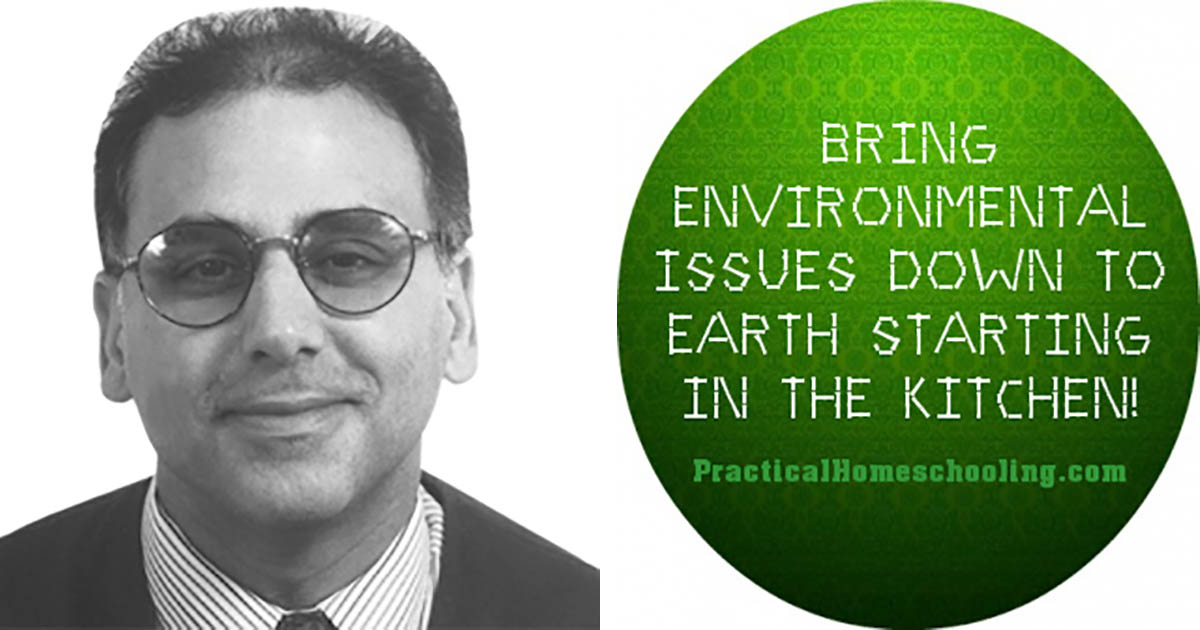Thinking Like A Scientist
By Jason Makansi
Printed in Practical Homeschooling #14, 1996.
 Jason Makansi tells us how to separate environmental fact from fiction, with "peanut butter" lessons you can teach right in your kitchen!
Jason Makansi tells us how to separate environmental fact from fiction, with "peanut butter" lessons you can teach right in your kitchen!

|
 |
 Most of us are overwhelmed by environmental issues - global warming, acid rain, electromagnetic fields, smog, hazardous waste, radon, asbestos, the ozone hole, and so on. The list seems like an endless stream of threats to ourselves and our children. Turn to the popular media and you're liable to be frightened even more!But surely there are sensible ways to use environmental issues in homeschooling curricula. After all, environmentalism is multi-dimensional, involving ecology, geography, science, industry, technology, politics, history, religion, even philosophy.
Most of us are overwhelmed by environmental issues - global warming, acid rain, electromagnetic fields, smog, hazardous waste, radon, asbestos, the ozone hole, and so on. The list seems like an endless stream of threats to ourselves and our children. Turn to the popular media and you're liable to be frightened even more!But surely there are sensible ways to use environmental issues in homeschooling curricula. After all, environmentalism is multi-dimensional, involving ecology, geography, science, industry, technology, politics, history, religion, even philosophy.
Of course there are. If you follow a few simple rules, you'll understand environmental issues a whole lot better than the talking heads on television that bring you the news each day. And you'll impart to your children how to "think before you act - globally or locally."
Step Up to the Scale
Let's first tackle the rule of "scale." If you understand the principle of relative scale, or size, you can put environmental issues in perspective. And the kitchen is a wonderful place to understand the principle of scale.
Suppose you are preparing peanut butter and jelly sandwiches for your kids. The peanut jar is almost empty. You try to be a good consumer and scrape what you can off the sides, because that saves a few pennies. But at some point, you give up because it is taking too much of your time or energy. So the plastic jar you throw away invariably has peanut butter stuck to the sides. A dirty knife has peanut butter on it. It goes into the sink. The knife is washed with water which goes down the drain to the sewer.
Now imagine a huge factory that makes peanut butter and jelly sandwiches that are distributed to the whole town you live in. It has a huge vessel that, when emptied, has peanut butter stuck to the sides. The operators at the plant scrape as much of the leftovers as possible out but there comes a point of diminishing returns. What they save by recovering peanut butter is lost because it takes too much of their time and probably takes too much energy. which also costs money. It has to be washed out. Now it's a little different than in your home! That water has to be treated and cleaned before it can be discharged.
Conservation Costs
Now what can we learn by comparing the small-scale peanut-butter sandwich making shop to the large manufacturing one? First, both face similar problems (the waste of peanut butter) but the relative size of the problem is different. Second, it should be evident that the environmental issue of wasted peanut has an energy component and an economic component. But for some reason, people think that the sandwich manufacturer has an obligation to solve the problem of wasted peanut butter, regardless of what it will cost. Third, the wasted peanut butter could be an environmental problem but it is also a waste-of-money problem in both cases - pennies in one case, hundreds of dollars each week in another.
The point here is that size or scale are what distinguishes environmental problems of industrial operations from those of individuals. And you can come up with many other parallels. How about a fire in the fireplace and a fire in a huge furnace at the local powerplant? Or the spreading of fertilizer on your lawn to the spreading of insecticide or pesticide on thousands of acres of cropland or orchards?
Understanding scale takes some of the mystery and magnitude away from an environmental issue. Also, if you and your kids can grasp individual responsibility, you can better understand what the industrial plant down the street is going through when it has to meet government mandates that might say wasting peanut butter is against the law. Finally, it moves us away from a knee-jerk reaction that the industrial facility is polluting and something has to be done about it right away.
Actually, this is the type of attitude that prevails today. The public seems to think that recycling is good and everything else is bad. But recycling has its own problems and can create other environmental situations.
Solving a Sticky Situation
A good activity for your kids would be to evaluate ways that the waste-peanut-butter problem could be solved. Here are some hints:
- Make the jar's surface so the peanut butter doesn't stick
- Change the shape of the jar so it is easier to scrape the peanut butter off the sides
- Use a knife or scraper that is shaped to reach more of the jar's surface.
- Cut the jar in two so the surfaces of two halves are easier to reach with a regular knife.
You can be sure that in serious, corporate meetings around the country, these same basic solutions are being discussed for the large-scale environmental problems we face. But they don't seem nearly as fearsome if you can relate them to everyday events!
Mixing Oil, Water and the Media
Here's another way to think about scale. Suppose the network news reported that an oil tanker spilled 50,000 gallons of oil into the ocean. That may sound like a lot. And the anchor person is probably going to make sure that it sounds like a lot. But think about how much oil is transported around the world every day - millions of barrels (one barrel equals 42 gallons!), hundreds of millions of gallons. One gallon = 231 cubic inches. If the oil spreads to an average 1/64 inch of thickness (with more in the middle, near the spill, and less on the edges), then can you calculate how much surface area 50,000 gallons would cover? (The answer is at the end of the article.)
Try spilling some oil yourself - pour a cup of oil into a kitchen container of known dimensions that's half-full of water. Can you figure out how much oil to pour to get it 1/4 inch thick on top of the water? How noticeable is a 1/4 inch oil layer? How about a thicker oil layer? Can you think of easy ways to clean most of the oil off the water? Try out your ideas!
Armed with these calculations and experiments, now you are in a position to ask, "Is the 50,000-gal-spill really such an environmental disaster, or are the thousands of pictures, video films, and clipping carried by the news media around the world simply making it a big deal? Should that company really be subjected to hundreds of millions of lawyer fees? Or could that money be better spent cleaning up a real environmental mess somewhere else?"
If you teach your kids how to break environmental and polution problems down "to scale," they will learn to think before they act - locally or globally!
Answer: First, multiply 50,000 gallons x 231 in3/gallon x 64/inch. This gives you the square inches a spill 1/64 inch thick covers. Then divide by 144 to ge the number of square feet. Finally find the square root. This tells you the length in feet per side of a square with that area.